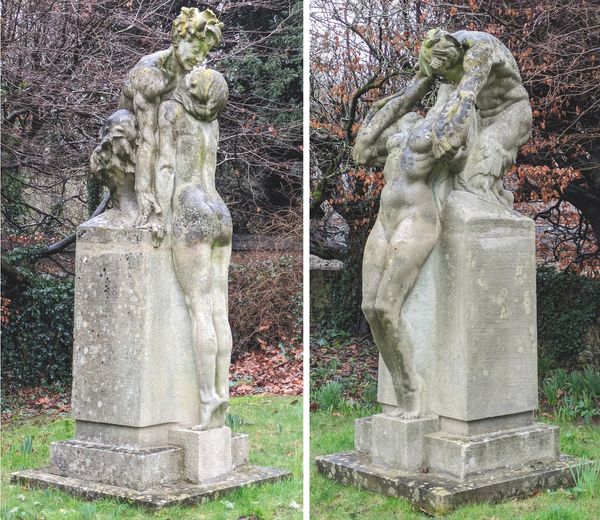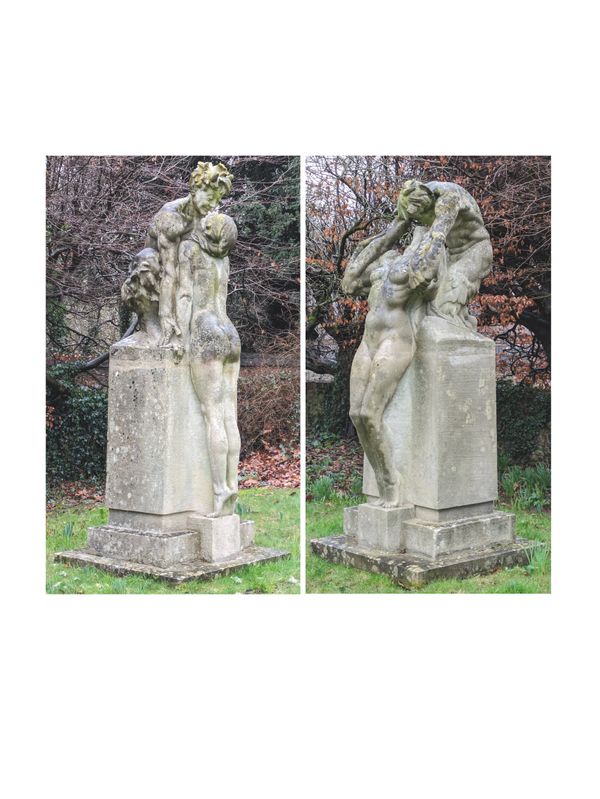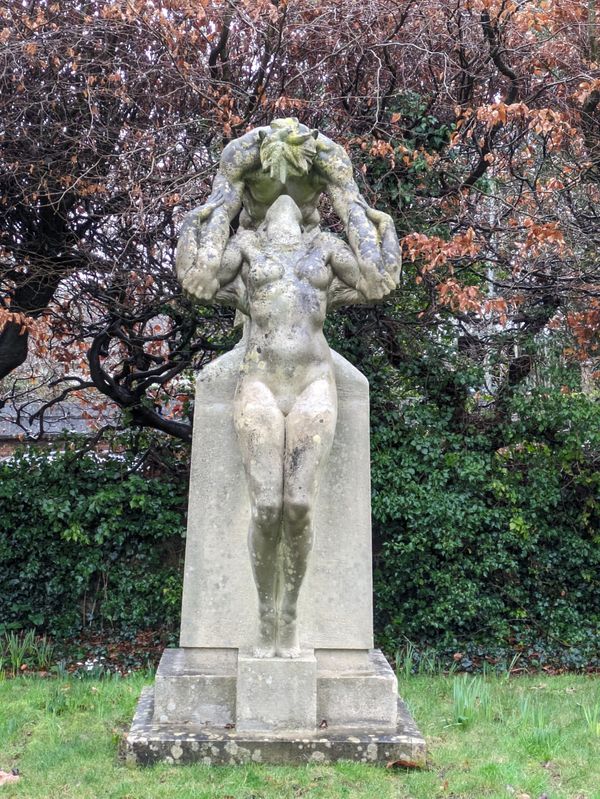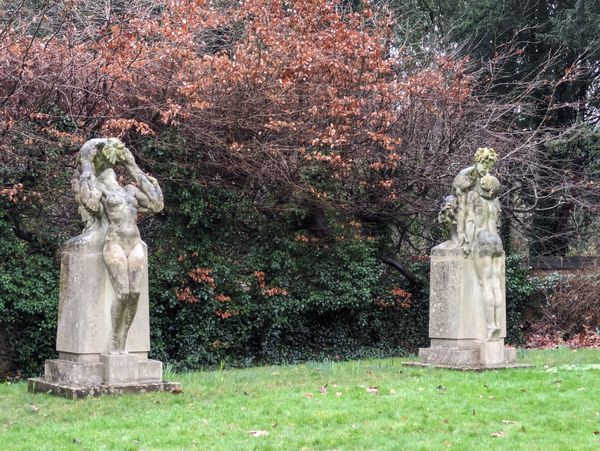each in the form of a satyr carved with curly hair and cloven hooves squatting on a tapering square pedestal and leaning over a naked nymph, one with the nymph with flowing hair facing towards him and raising herself on tiptoe to offer a kiss, the other with the nymph leaning backwards the satyr grasping her arms and pulling her up towards his embrace, 350cm high
*** This lot is being sold insitu - appointments can be made to view***
| Estimate: | £140,000 - £220,000 |
| Hammer price: | £140,000 |
Provenance: Melchett Court, Hampshire, 1927
Alfred 1st Lord Melchett Colworth, Bedfordshire 1936, Henry 2nd Lord Melchett, Beale Park, Berkshire, 1948
Charles Sargeant Jagger was born at Kilnhurst, Yorkshire on 17th December 1885, the second child of Mary (née Sargeant) and Enoch Jagger, he had a younger brother David who later became a society portrait painter, and an older sister Edith, who also became a gifted painter. Their father was a colliery manager. In 1907 he was awarded a scholarship by West Riding county council to study at the Royal College of Art. Under Professor Lanteri he achieved considerable success including a major college travel bursary which enabled him to visit Italy and North Africa in 1911.
In 1914 he was awarded the Prix de Rome, with a relief entitled Bacchanalian Scene. The romantic classical feeling of his work at this time was not to be repeated until the late 1920’s when the Melchett Court groups were commissioned. Before he could take up his scholarship in Rome war was declared and Jagger made a considerable personal sacrifice by renouncing it and instead enlisting in the Artists Rifles.
In 1915 he sailed with the British Expeditionary Force to Gallipoli. In the most appalling conditions, he was eventually shot through the shoulder and shipped out to a hospital in Malta. He was subsequently posted to the Front in France and in April 1918 was badly wounded at the Battle of Neuve Église. In recognition of his valour he was awarded the Military cross.
Whilst he was convalescing a friend at the Royal College of Art told him that the British War Memorials Committee were about to employ sculptors. In 1919 Sir George Frampton (who had been on the panel judging the Rome scholarship) recommended him to design a memorial planned for Hoylake and West Kirby, Lancashire. This proved a turning point in his career, and between 1921 and 1923 he completed six war memorials and started on his most well-known work, the Royal Artillery memorial at Hyde Park Corner. All of these are characterized by the same brutal and grim, but also massively strong treatment of the soldiers or ‘Tommies’. His recorded comments on war memorials repeat the basic notion of ‘showing the Tommy as I knew him in the trenches’.
There followed a number of other commissions both at home and abroad for the Imperial War Graves Commissions. By the second half of the 1920’s Jagger’s eminence as a sculptor had become established. The Royal Artillery Memorial had a somewhat mixed reception when it was unveiled in 1925, but nevertheless secured Jagger’s name as a public figure.
In 1926 he became an associate of the Royal Academy and was awarded a medal by the Royal Society of British Sculptors. At this time Jagger also built up an influential circle of patrons, including Sir Edwin Lutyens, who also became a close friend, and Sir Stephen Courtauld, who commissioned two decorative plaques from him. He was also commissioned to do a statuette of H.R.H. the Prince of Wales. The Prince was known to have admired Jagger’s work and commissioned a cast of one of Jagger’s bronzes. ‘Wipers’ in 1921. This informal portrait of the Prince portrayed holding a tennis racquet was considered one of Jagger’s finest works and helped him avoid being stereotyped as a war memorial sculptor.
It was also at this time that Jagger began his association with Sir Alfred Mond, the first Lord Melchett, and his son Henry. Sir Alfred served on the council of the British School at Rome from 1925, but already knew Jagger’s work. It is likely that they got to know each other as a result of the work Jagger did for the British War Memorials commission. Mond was heavily involved in setting up the Imperial War Museum which took over the commissions made by the B.W.M.C. at the end of 1918 and so probably saw Jagger’s work at that time.
Certainly, from the early 1920’s the Mond family were active supporters of Jagger’s work and from this association there emerged a close relationship between them. Charles Jagger and Henry Mond, who were almost the same age, were particularly close and the Jaggers often visited the Monds at their Hampshire home.
Amongst the many commissions the Mond family gave Jagger, were the sculptures on Imperial Chemical House. This building, a well-known London landmark on the River Thames at Millbank, was designed by Sir Frank Baines to provide the central offices of I.C.I. when it was formed out of a merger between companies belonging to the Mond family and to Sir Harold McGowan in 1926. Jagger produced four massive sculptures typifying great industries of the world, Agriculture, Marine Transport, the Building Industry and Chemistry.
At around the same time Jagger was commissioned by Lord Melchett to carve this pair of Portland stone groups of nymphs and satyrs for his home, Melchett Court, Hampshire. These form an important part of a small group of privately commissioned works on literary and classical themes. In a similar vein Jagger produced a relief based on Sheridan’s School for Scandal for Henry and Gwen Mond’s drawing room at Mulberry House, Smith Square, London. This features a man embracing a naked woman. Also, a pair of reliefs for Sir Stephen Courtauld circa 1930 feature a nymph and a satyr mocking an elderly satyr who is offering jewels to the young nymph. The Melchett Court satyrs and nymphs are the only known work by Jagger in which he explores this romantic classical approach with its mildly erotic overtones in a large-scale three-dimensional way. The salacious expression of the squatting and kneeling satyrs contrasts brilliantly with the yearning expressions of the nymphs with their languid nubile bodies. The gentle satire employed in these works is striking because of the contrast it makes with the serious subject matter of much of Jagger’s work. It reinforces the view that he felt no obligation to be predictable concerning the content of his work.
The Courtauld reliefs and the Melchett Court nymphs and satyrs also reveal that Jagger’s romantic temperament, which is evident in this works prior to 1914, had not been entirely crushed by his experiences during the War. All the same, these later works are easily distinguishable from the earlier classical reliefs by their boldness and simplicity of form which is distinctly Art Deco.
Jagger died in November 1934 at the early age of 48. Between 1918 and 1934 Jagger produced some 45 works, most of which were war memorials or commissions for large buildings. These groups are amongst the most important of the private commissions which he undertook.
Following his death these two groups were exhibited in the Charles Sargeant Jagger Memorial Exhibition at the Royal Society of Painters in watercolours in Pall Mall, on 21st May to 20th June 1934. The chairman was Lord Melchett. The exhibition list also includes small bronzes of the nymphs and satyrs priced at 25 guineas each, which presumably were maquettes for the full-size groups. Sadly, no price is given for these, however since they formed an integral part of Melchett Court it is doubtful whether they would have been for sale. A plaster maquette of one the groups was included in a sale at Sotheby’s Sussex on 21st April 1998, lot 663.
The sculptures were moved to Colworth, Bedfordshire by Henry, 2nd Lord Melchett in 1936. This house was subsequently sold to Unilever as a research centre in 1947 and the following year the statues and other works of art were disposed of in a house sale, and subsequently acquired by Gilbert Beale for Beale Park and then sold at
Sotheby’s Sussex, 26 September 2000, lot 391
Literature: Imperial War Museum, 1985, edited by Ann Compton; Studio Magazine, Vol. 63, No.260, 14th November 1914; Charles Sargeant Jagger Memorial Exhibition catalogue, May/June 1935.
Garden ornament, centrepiece
© 2021 All rights reserved.









